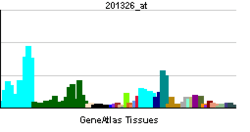CCT6A
| Chaperonin containing TCP1, subunit 6A (zeta 1) | |||||||||||||
|---|---|---|---|---|---|---|---|---|---|---|---|---|---|
| Identifiers | |||||||||||||
| Symbols | CCT6A ; CCT-zeta; CCT-zeta-1; CCT6; Cctz; HTR3; MoDP-2; TCP-1-zeta; TCP20; TCPZ; TTCP20 | ||||||||||||
| External IDs | OMIM: 104613 MGI: 107943 HomoloGene: 1336 GeneCards: CCT6A Gene | ||||||||||||
| |||||||||||||
| RNA expression pattern | |||||||||||||
 | |||||||||||||
 | |||||||||||||
| More reference expression data | |||||||||||||
| Orthologs | |||||||||||||
| Species | Human | Mouse | |||||||||||
| Entrez | 908 | 12466 | |||||||||||
| Ensembl | ENSG00000146731 | ENSMUSG00000029447 | |||||||||||
| UniProt | P40227 | P80317 | |||||||||||
| RefSeq (mRNA) | NM_001009186 | NM_009838 | |||||||||||
| RefSeq (protein) | NP_001009186 | NP_033968 | |||||||||||
| Location (UCSC) | Chr 7: 56.12 – 56.13 Mb | Chr 5: 129.79 – 129.85 Mb | |||||||||||
| PubMed search | |||||||||||||
T-complex protein 1 subunit zeta is a protein that in humans is encoded by the CCT6A gene.[1][2][3]
Function
This gene encodes a molecular chaperone that is member of the chaperonin containing TCP1 complex (CCT), also known as the TCP1 ring complex (TRiC). This complex consists of two identical stacked rings, each containing eight different proteins. Unfolded polypeptides enter the central cavity of the complex and are folded in an ATP-dependent manner. The complex folds various proteins, including actin and tubulin. Alternate transcriptional splice variants of this gene, encoding different isoforms, have been characterized.[3]
Interactions
CCT6A has been shown to interact with PPP4C.[4][5]
References
- ↑ Segel GB, Boal TR, Cardillo TS, Murant FG, Lichtman MA, Sherman F (August 1992). "Isolation of a gene encoding a chaperonin-like protein by complementation of yeast amino acid transport mutants with human cDNA". Proc Natl Acad Sci U S A 89 (13): 6060–4. doi:10.1073/pnas.89.13.6060. PMC 49437. PMID 1352881.
- ↑ Li WZ, Lin P, Frydman J, Boal TR, Cardillo TS, Richard LM et al. (August 1994). "Tcp20, a subunit of the eukaryotic TRiC chaperonin from humans and yeast". J Biol Chem 269 (28): 18616–22. PMID 8034610.
- ↑ 3.0 3.1 "Entrez Gene: CCT6A chaperonin containing TCP1, subunit 6A (zeta 1)".
- ↑ Chen GI, Tisayakorn S, Jorgensen C, D'Ambrosio LM, Goudreault M, Gingras AC (October 2008). "PP4R4/KIAA1622 Forms a Novel Stable Cytosolic Complex with Phosphoprotein Phosphatase 4". J. Biol. Chem. 283 (43): 29273–84. doi:10.1074/jbc.M803443200. PMC 2662017. PMID 18715871.
- ↑ Gingras AC, Caballero M, Zarske M, Sanchez A, Hazbun TR, Fields S et al. (November 2005). "A novel, evolutionarily conserved protein phosphatase complex involved in cisplatin sensitivity". Mol. Cell Proteomics 4 (11): 1725–40. doi:10.1074/mcp.M500231-MCP200. PMID 16085932.
Further reading
- Dawson SJ, White LA (1992). "Treatment of Haemophilus aphrophilus endocarditis with ciprofloxacin". J. Infect. 24 (3): 317–20. doi:10.1016/S0163-4453(05)80037-4. PMID 1602151.
- Kubota H, Hynes G, Carne A, Ashworth A, Willison K (1994). "Identification of six Tcp-1-related genes encoding divergent subunits of the TCP-1-containing chaperonin". Curr. Biol. 4 (2): 89–99. doi:10.1016/S0960-9822(94)00024-2. PMID 7953530.
- Schwartz GJ, Kittelberger AM, Segel GB (2000). "Cloning of rabbit Cct6 and the distribution of the Cct complex in mammalian tissues". Exp. Nephrol. 8 (3): 152–60. doi:10.1159/000020663. PMID 10810232.
- Yokota S, Yanagi H, Yura T, Kubota H (2001). "Cytosolic chaperonin-containing t-complex polypeptide 1 changes the content of a particular subunit species concomitant with substrate binding and folding activities during the cell cycle". Eur. J. Biochem. 268 (17): 4664–73. doi:10.1046/j.1432-1327.2001.02393.x. PMID 11532003.
- Gevaert K, Goethals M, Martens L, Van Damme J, Staes A, Thomas GR et al. (2004). "Exploring proteomes and analyzing protein processing by mass spectrometric identification of sorted N-terminal peptides". Nat. Biotechnol. 21 (5): 566–9. doi:10.1038/nbt810. PMID 12665801.
- Imai Y, Soda M, Murakami T, Shoji M, Abe K, Takahashi R (2004). "A product of the human gene adjacent to parkin is a component of Lewy bodies and suppresses Pael receptor-induced cell death". J. Biol. Chem. 278 (51): 51901–10. doi:10.1074/jbc.M309655200. PMID 14532270.
- Bouwmeester T, Bauch A, Ruffner H, Angrand PO, Bergamini G, Croughton K et al. (2004). "A physical and functional map of the human TNF-alpha/NF-kappa B signal transduction pathway". Nat. Cell Biol. 6 (2): 97–105. doi:10.1038/ncb1086. PMID 14743216.
- Higo M, Uzawa K, Kouzu Y, Bukawa H, Nimura Y, Seki N et al. (2005). "Identification of candidate radioresistant genes in human squamous cell carcinoma cells through gene expression analysis using DNA microarrays". Oncol. Rep. 14 (5): 1293–8. doi:10.3892/or.14.5.1293. PMID 16211299.
- Guo D, Han J, Adam BL, Colburn NH, Wang MH, Dong Z et al. (2005). "Proteomic analysis of SUMO4 substrates in HEK293 cells under serum starvation-induced stress". Biochem. Biophys. Res. Commun. 337 (4): 1308–18. doi:10.1016/j.bbrc.2005.09.191. PMID 16236267.